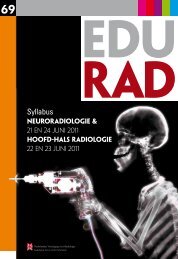Create successful ePaper yourself
Turn your PDF publications into a flip-book with our unique Google optimized e-Paper software.
eduRAD syllabus 67MDCT (UROGRAPHY) and MRIof urinary bladder cancerProf. dr. J.O. Barentsz 1 , Dr. R.H. Cohan 21Afdeling radiologie, UMC St Radboud, Nijmegen2University Of Michigan Medical Center, Ann Arbor, USAOmdat een groot deel over CT is overgenomen uit de ESURsyllabus 2010, is mijn bijdrage in het Engels.INTRODUCTIONUrothelial cancer is the second most common genitourinarytract cancer (after prostate cancer). The vast majority ofneoplasms are located in the bladder, likely due to thedisproportionate amount of urothelium present in the bladder.These tumors are believed to result from a combinationof genetic and environmental factors, with the most commonenvironmental risk factors being cigarette smoke and occupationalexposure to carcinogens (1, 2). Traditionally, imaginghas played a limited role in the detection and staging ofurothelial cancers, due to its limited utility in evaluatingthe bladder; however, recent studies have shown that CTurography (CTU) is often able to detect urothelial neoplasmsin the bladder.CTU TECHNIQUEOptimal CTU technique for imaging the upper tracts andthe bladder requires that thin section images (no more than2.5 mm thickness reconstructed at no greater than 2.5 mmintervals) be obtained for review and that axial images besupplemented with reformatted images in orthogonal planes(usually in the coronal plane). There is a difference in opinionconcerning the optimal CTU technique that should be usedto optimize sensitivity for detection of bladder abnormalities.Some investigators obtain uniform opacification ofthe bladder with excreted contrast material (which oftenrequires that the patient be moved and turned prior to imageacquisition) (3), while others believe that bladder cancers areusually equally well detected when outlined by opacified orunopacified urine (4). Most CTU protocols employ imagingof the bladder during the excretory phase of excretion beginningat least 5-7 minutes after contrastmaterial administration(3-6), although a few researchers have shown that manybladder cancers can be detected when imaged during theportal venous phase (at 60-70 seconds after contrast materialadministration) due to the fact that they enhance morethan does normal urothelium (7). Our current protocol utilizesa double split-bolus technique with the bladder imaged 12minutes after the first injection (of 100 ml of 300 mg I/mlnonionic contrast material) and 2 minutes after the secondinjection (of 75 ml). We do not move the patient after contrastmaterial has been injected. When patients are imagedin this fashion, bladder tumors often demonstrate residualabnormal enhancement, while the majority of the bladderlumen is also opacified with excreted contrast material.CT UROGRAPHIC DETECTION OF BLADDERCANCERS IN PREVIOUSLY UNTREATEDPATIENTSRecent studies have demonstrated that CTU has a highsensitivity (79-100%) in detecting bladder cancers (3-6, 10).On CTU, bladder cancers most often produce areas of asymmetricallyincreased bladder wall thickening. Sometimes, thethickening is so pronounced that mass-like areas are produced.Conversely, when the neoplasms are small, they mayappear as tiny projections into the bladder lumen. In theseinstances, a specific diagnosis usually can be suggested.Rare bladder cancers may produce diffuse symmetric circumferentialwall thickening. In these cases, the abnormality canbe mistaken for cystitis. Several previously published serieshave found that certain types of bladder neoplasms aremore likely to be missed by CTU. Those that have been mostfrequently missed are flat, small, and located at the bladderbase (4, 5). Bladder base lesions are problematic, becausethe bladder mass may not be distinguishable from adjacentprostatic or perineal tissue. False positive diagnoses mayalso occur. On rare occasions, patients with cystitis canhave focal bladder abnormalities that mimic small urothelialneoplasms.CT UROGRAPHIC DETECTION OF BLAD-DER CANCERS IN PREVIOUSLY TREATEDPATIENTSOnce a patient has been treated for superficial (noninvasive)bladder cancer, the bladder wall often demonstrates residualareas of inflammation and fibrosis. These changes can produceCTU findings that can be confused with cancers, suchas lobulated or irregular bladder wall thickening or smallmasses projecting into the bladder lumen (3, 11). Conversely,some bladder cancer recurrences in treated bladders can bemisdiagnosed as areas of post-treatment change.STAGING OF BLADDER CANCERBladder cancer is staged according to the TNM system asfollows:22I n s c h r i j v e n v i a w w w . c o n g r e s s c o m p a n y . c o mo f w w w . r a d i o l o g e n . n l



